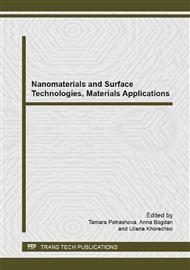[1]
V. A. Baranov, D. K. Avdeeva, P. G. Pen'kov, M. M. Yuzhakov, I. V. Maksimov, M. V. Balahonova, M. G. Grigoriev, Structural approach to inverse problems of computerized diagnostics in cardiology, Modern problems of science and education. 50 (2013).
Google Scholar
[2]
D. K. Avdeeva, O. N. Vylegzhanin, Extraction from registered cardioimpulse orthogonal to it low-amplitude component, Naukovedenie. 19 (2013) (in Russian).
Google Scholar
[3]
D. K. Avdeeva, V. Yu. Kazakov, N. M. Natalinova, M. L. Ivanov, The results modeling of high frequency filter and low-pass filter effects to the micropotentials recording quality on the electrocardiogram, Naukovedenie. 19 (2013) (in Russian).
Google Scholar
[4]
D. K. Avdeeva, N. V. Turushev, N. M. Natalinova, M. L. Ivanov, Analysis of the impact of filtering links on electroencephalogram and electromyogram registered channel highly sensitive to nanoelectrodes, Naukovedenie. 19 (2013) (in Russian).
Google Scholar
[5]
Information on http: /www. who. int/mediacentre/factsheets/fs317/en.
Google Scholar
[6]
Information on http: /www. medicus. ru/fphysician/patient/bolezni-kotorye-ubivayut-34765. phtml.
Google Scholar
[7]
Bor Kavcic, Electrodynamics of human heart, Seminar 1b-1. year, II. cycle program, University of Ljubljana Faculty of Mathematics and Physics, (2013).
Google Scholar
[8]
Information on http: /en. wikipedia. org/wiki/Alexander_Muirhead.
Google Scholar
[9]
Information on http: /www. med-group. ru/productdetail/000-000-051/28/0/0.
Google Scholar
[10]
Information on http: /www. stormoff. ru/catalog_40_8. html.
Google Scholar
[11]
Information on http: /www. davismedical. com/GE-MAC-5500-EKG.
Google Scholar
[12]
Information on http: /www. agiannidis-medizintechnik. com/hardware/hellige_cardiosmart_st. htm.
Google Scholar
[13]
Yu. E. Yel'kin, The simplest models of excitable media, Mathematical cell (in Russian).
Google Scholar
[14]
V. A. Baranov, U. Ewert, Methods of statistical spatial filtering of images on the basis of local group of transformations, Russian Journal of Nondestructive Testing, 2 (2012) 123 - 128.
DOI: 10.1134/s1061830912020039
Google Scholar
[15]
V. A. Baranov, U. Ewert, Symmetrical aspects of the causality principle in statistical group-theoretical image-reconstruction methods. Russian Journal of Nondestructive Testing, 3 (2012) 187 - 190.
DOI: 10.1134/s1061830912030023
Google Scholar
[16]
V. A. Baranov, U. Ewert, Quasi-tomograpic visualization of crack-formation zones using radiographic projections methods. Russian Journal of Nondestructive Testing, 4 (2012) 245 - 249.
DOI: 10.1134/s1061830912040031
Google Scholar
[17]
Grigoriev, M.G., N.V. Turushev D.K. Avdeeva, Human body electroneuromyographic diagnostics device. Journal of Radio Electronics, 4 (2014) (in Russian).
Google Scholar


